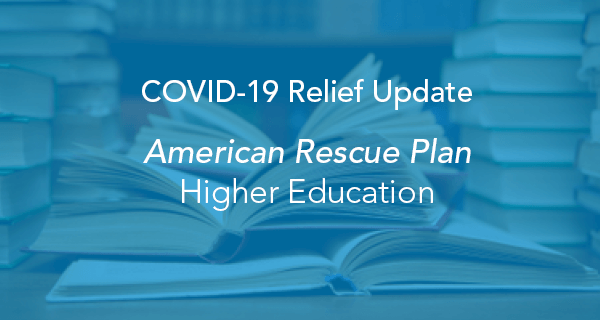The third round of significant COVID-19 stimulus funding was signed into law on March 11, 2021. The American Rescue Plan Act of 2021 (ARP) includes various items, including aid for vaccinations and testing, state and local governments, schools, rental assistance, agriculture, and the airline industry. The ARP also includes several tax-related provisions and additional business relief. This article details the higher education components.
The Higher Education community has received significant benefits from the various stimulus bills over the past 12 months. The CARES Act allocated approximately $14 billion in funding and the Consolidated Appropriations Act, 2021 added $23 billion for a total of approximately $37 billion before ARP.
ARP allocates an additional $40 billion (available through September 30, 2023) to the Higher Education Emergency Relief Fund (HEERF). The new appropriation follows closely the allocation methodology, terms, and conditions in the second stimulus legislation, Coronavirus Response and Relief Supplemental Appropriations Act, 2021 (CRRSAA). Under the ARP, 91% of the total funds (versus 89% under the CRRSAA), or $36 billion, will be allocated to institutions based on a methodology of:
- 75% on Pell Grant-eligible students
- 25% on remaining enrollment (not Pell-eligible).
At least 50% of the funds must be used to provide emergency financial aid grants to students. The funds can be used for the same items as under the CRRSAA:
- To defray expenses associated with COVID-19 (including lost revenue, reimbursement for expenses already incurred, technology costs associated with a transition to distance education, faculty and staff training, and payroll); carry out student support activities authorized by the Higher Education Act of 1965, as amended (HEA) that address needs related to COVID-19
- Make additional financial grants to students, which may be used for any component of the student’s cost of attendance or for emergency costs that arise due to COVID-19, such as tuition, food, housing, health care (including mental health care), or child care
Also, the ARP requires that a portion of funds received should be used to:
- Implement evidence-based practices to monitor and suppress COVID-19 under public health guidelines
- Conduct direct outreach to financial aid applicants about the opportunity to receive a financial aid adjustment due to the recent unemployment of a family member or independent student, or other circumstances, described in §479A of the HEA
We will continue monitoring this program and update you as more information comes from the Department of Education.
For more information on COVID-19 relief efforts, click the button below:
Do you have questions about the new American Rescue Plan Act? Contact your Dean Dorton advisor, or contact us at:
